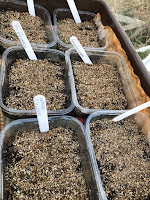Sally Nex, writing in the RHS magazine this month, has taken
a novel approach to weed removal. She
has reclassified her weeds as ‘wildflowers’, and all of a sudden – a weed-free
plot. Having a very wildflower-y lawn, I
can go along with that; our lawn isn’t a model of perfection by any means, but it
is never treated with chemicals, is very colourful between mowings, and boasts
a fine colony of cowslips and three species of orchid, which we mow around. Some of the lawn weeds, especially couch
grass and creeping potentilla, make a nuisance of themselves by creeping into
adjacent beds, where I try to deal with them as best I can; but not all of my ‘plants
in the wrong place’ are actually wildflowers.
Take the alpine strawberries (variety ‘Baron Solemacher’) and
the oregano. Both are definitely
‘plants’ not ‘wildflowers’ – I introduced them into the garden – that took to
growing prolifically in the veg plot (and elsewhere). I like both plants very much; as well as
being useful in the kitchen, they’re attractive to wildlife, especially the
oregano, which is enjoyed by butterflies when in flower and by goldfinches when
seeding. They used to pop up uninvited
in places where I never intended them to grow, and I allowed and even
encouraged them since they were highly desirable plants. Things came to a head when they colonised
some of the veg plot paths, and I found myself walking on the veg beds so as
not to trample them. Something had
clearly gone wrong there. When I
considered why I was taking this lopsided view, I realised that I was
tolerating them because neither plant had a dedicated place where they were
supposed to grow: the strawberries did have two very small beds in the veg plot
(one of which had fallen out of use), but since the berries are very small, I
needed more plants elsewhere to produce a decent crop, and the herb bed where
the oregano was supposed to live had not really worked out and had been
repurposed for other plants. Both have
been weeded out of the paths, and I’m now considering dedicated quarters for
them in future.
One of my latest weeding jobs has been removing them from
the raspberry patch. Crawling around
under the raspberry canes and trying to winkle out the weeds hasn’t been one of
my favourite jobs, so it doesn’t get done every year, but this year it has
suddenly become easier. I’ve noticed in
recent seasons that the raspberries are not doing as well as they once did, and
this year about half of the canes haven’t produced any stems, leaving big bare
patches in the bed. The plants were in
the garden when we came here, 30 years ago (already!), and I’ve been
considering replacing them for a while, so I think the time has come. My plan is to let the remaining canes fruit
and then to dig them out, clear the whole bed, and replant, with a mixture of
the traditional summer-fruiting and the newer autumn-fruiting varieties.
I’ve now cleared the part of the bed with no surviving canes,
removing the weeds as I went. Both the
couch grass and the horrible potentilla had made inroads from the lawn into the
patch, but not very seriously; it was mostly the oregano and alpine
strawberries that needed to be dealt with. They
actually work very well as underplanting for raspberries; they don’t get in the
way of the canes, they suppress weeds by covering what would otherwise be bare
soil and, being edibles, they’re a sensible planting in the fruit patch. I may well reinstate at least the
strawberries when I replant the bed (the oregano can be a bit too invasive and
is less easy to dig out); a few of the plants I removed have been temporarily
bedded in a spare corner for that purpose.
Actually the further half of the raspberry bed has been out
of commission completely for a few years, and that also needs clearing. There’s a lot of ivy, but there’s also a
large clump of Iris foetidissima. I’m
tolerant of the iris, because the un-showiness of its flowers is offset by the
fine shiny leaves and the bright orange seeds in winter, both good in flower
arrangements and cheering in the garden.
It is actually a real native wildflower, but it mostly appears in
gardens because someone has planted it or because it has seeded in from another
garden. So is it a ‘wildflower’ or a
‘plant’? Either way, it is going to be
removed; it’s happy to grow in deep shade and in poor soil (and does so
elsewhere in the garden), so having it in a sunny(ish) place and in good soil is
a waste of a good garden situation. (Thinking
about it, that’s also true of the alpine strawberries. Maybe I need to consider further.)
In the meantime, there is now some clear ground in the patch
which can be put to good use for temporary planting. As usual, I’ve been overenthusiastic about
sowing lettuce seeds: six varieties, and because I can never bring myself to
believe that most of the seeds will germinate, I have far too many seedlings
coming through. Some of them might find
themselves in with the raspberries in due course.
 |
| Lettuce, just starting to germinate |

No comments:
Post a Comment